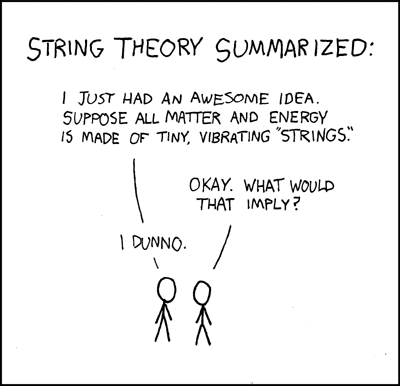I do not know the reasons for this, but I can make basic assumptions about the two fields. Communication has humans, people, and their interactions as its focus, but physics concerns the interaction between forces, atoms, and particles that are not sentient or of free will. Although humans and particles are quite different in their motivations, actions, and behavior, the two fields actually overlap quite a bit. Both are concerned with interactions, relationship, causes and effects, and patterns. Both fields are also undergoing large arguments about the purpose of the field and how it can be united into one universal theory. For communication scholars, the journey to defining "communication" and linking disparate scholars (from cultural studies to rhetoric to psychology) in their ideology and methodology has been a task thus far daunting and unreachable.
The Theory of Everything is an equally inscrutable theory of physics that links all physical phenomena under one theoretical boundary. The purpose of creating these overarching theories is not lost on me, but I fear they may never be fully realized, especially in our lifetime. The main issue that links both physics and communication in their search for the theories of everything is to find the balance between application and oversimplification. For physics, the search for the universal theory of everything is admission that some theoretical concepts do not universally apply to everything. Fundamental forces are grouped into two categories, general relativity and the three: electromagnetism, weak, and strong forces. These two groups operate under opposing principles, meaning currently, physicists are still pondering the universal forces that govern all interactions. From the rotation and orbits of planets, to the relationship between atoms and particles, there is no one solution to how forces work. The current contender for the theory of everything is "string" theory, that changes the way that matter is defined in order to negotiate the hypocrisy between weak and strong forces. Unfortunately, the theory is still being developed and is not yet being used by current researchers.
 |
| XKCD.com |
I am skeptical that such unified theories will ever truly exist, at least not in ways that everyone can agree on. For what purpose is a communication theory that discounts racial, ethnic, or gender differences? How applicable can a theory be that does not acknowledge the impact of technology, networks, and relationships among people? There are so many different aspects of communication, that to create a unified theory must privilege some and reject others. Reducing the varied, exciting, and unique field of communication to one theory would undermine the ability of researchers to address specific problems, artifacts, and inquiries with the most appropriate theoretical tool. The theory of everything for physics would mainly help simplify physical formulas and streamline research and data, but little would change for most researchers. Simply because, current theories function well to predict small interactions, and general relativity functions well to predict large interactions. Combining them would change very little about these predictions, except for that they would be linked. The one exception would be for those objects that are both tiny and massive; namely, black holes complicate this separation. Black holes are massive, but occupy very little space, so theoretically, both sets of theories should apply, and yet, they cannot.
I applaud scholars whose research finds them looking to larger, theoretical problems. I believe that most researchers, though, might find their time better spent analyzing and solving smaller, more meaningful communication and physics issues.
 |
| Smbc-comics.com |

No comments:
Post a Comment